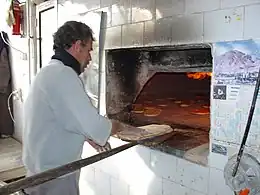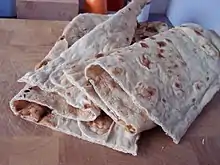 | |
| Place of origin | Iran |
|---|---|
| Region or state | Razavi Khorasan |
| Main ingredients | Flour |

Barbari bread (Persian: نان بربری, romanized: nân-e barbari) is a type of yeast leavened flatbread. It is one of the thickest flat breads and is commonly topped with sesame or black caraway seeds. A notable characteristic of the bread is its top skin that is similar to pretzels or lye roll's skin due to the Maillard reaction that occurs during baking. Before baking it is glazed with a mixture of baking soda, flour and water. It is widely known as Persian flatbread in United States and Canada.[1][2]
Etymology
Barbari bread traces back to the Qajar era when a nomadic Persian tribe known as "Barbari"[3] living in the mountanious regions of Khorasan province of Iran introduced the bread to the wider regions of Iran.
While the term "Barbari" for this tribe was replaced by "Khavari" by royal edict of Mohammad Reza Pahlavi,[4] the bread itself kept its title and is now commonly known as "nān-e barbari" in Iran.
Widespread claims that the term refers to Hazaras are dubious and unsubstantiated by evidence. [5]
Manufacture and style
The bread is usually 70 cm to 80 cm long, and 25 cm to 30 cm wide.[6] It is the most common style baked in Iran. It is served in many restaurants with Lighvan cheese, a ewe's milk cheese similar to feta cheese.[7]
See also
References
- ↑ Ram, Sewa (2009). Cereals: Processing and Nutritional Quality. New India Publishing. p. 27. ISBN 978-9-380-23507-3.
- ↑ "Nan-e Barbari". Reform Judaism. Archived from the original on 31 January 2016. Retrieved 4 May 2015.
- ↑ Ali Akbar Dehkhoda, Dehkhoda Lexicon, Origins of the term "Barbari" in Iran,
The "barbar" were a nameless nomadic Persian tribe living in desert regions of North-East Iran
- ↑ Shobhas Food Mazaa, Change of title "Barbari" to "Khavari",
The Barbars hated being referred by such a name and Reza Shah granted them the name Khavari (Easterners)
- ↑ Talk, There is no evidence substantiating a link between the term "Barbari" and Hazara people
- ↑ Qarooni, Jalal (2012). Flat Bread Technology. Springer Science & Business Media. p. 75. ISBN 978-1-461-31175-1.
- ↑ "Persian Nan o Paneer (Bread with Cheese)". Reform Judaism. Archived from the original on 4 March 2016. Retrieved 1 January 2016.
